Health Evaluation and Risk Factor Identification of Urban Lakes—A Case Study of Lianshi Lake
Abstract
:1. Introduction
2. Materials and Methods
2.1. Study Region
2.2. Water Ecological Experiment
2.3. Urban Lake Health Evaluation Framework
2.4. Index System
2.5. Assessment Criteria
2.6. Assessment Method
3. Results and Discussion
3.1. Health Assessment
3.2. Risk Factor Identification
3.2.1. Calculation of Standard Differential Rate
3.2.2. Identifying Lake Health Risk Areas
3.2.3. Identification of Major Risk Factors
3.3. Understanding of Integrated Lake Management
4. Conclusions
Author Contributions
Funding
Acknowledgments
Conflicts of Interest
References
- Vitousek, P.M.; Mooney, H.A.; Lubchenco, J.; Melillo, J.M. Human domination of Earth′s ecosystems. Science 1997, 277, 494–499. [Google Scholar] [CrossRef] [Green Version]
- Daily, G. Developing a scientific basis for managing Earth’s life support systems. Conserv. Ecol. 1999, 3, 14. [Google Scholar] [CrossRef] [Green Version]
- Daily, G.C.; Söderqvist, T.; Aniyar, S. The value of nature and the nature of value. Science 2000, 289, 395–396. [Google Scholar] [CrossRef] [Green Version]
- Schaeffer, D.J.; Herricks, E.E.; Kerster, H.W. Ecosystem health: I. Measuring ecosystem health. Environ. Manag. 1988, 12, 445–455. [Google Scholar] [CrossRef]
- Ryder, R.A. Ecosystem health, a human perception: Definition, detection, and the dichotomous key. J. Great Lakes Res. 1990, 16, 619–624. [Google Scholar] [CrossRef]
- Robert, C.; Michael, M. What is a healthy ecosystem? Aquatic Ecol. 1999, 33, 105–115. [Google Scholar] [CrossRef]
- Vörösmarty, C.J.; Mcintyre, P.B.; Gessner, M.O.; Dudgeon, D.; Prusevich, A.; Green, P.; Glidden, S.; Bunn, S.E.; Sullivan, C.A.; Liermann, C.R. Global threats to human water security and river biodiversity. Nature 2010, 467, 555–561. [Google Scholar] [CrossRef]
- Su, M.R.; Zhang, Y.; Liu, G.Y.; Xu, L.Y.; Zhang, L.X.; Yang, Z.F. Urban Ecosystem Health Assessment: Perspectives and Chinese Practice. Int. J. Environ. Res. Public Health 2013, 10, 5874–5885. [Google Scholar] [CrossRef] [Green Version]
- Rapport, D. Ecosystem Health: Exploring the Territory. Ecosyst. Health 1995, 1, 5–13. [Google Scholar]
- Loreau, M. Biodiversity and Ecosystem Functioning: Current Knowledge and Future Challenges. Science 2001, 294, 804–808. [Google Scholar] [CrossRef] [Green Version]
- Diaz, R.J.; Solan, M.; Valente, R.M. A review of approaches for classifying benthic habitats and evaluating habitat quality. J. Environ. Manag. 2004, 73, 165–181. [Google Scholar] [CrossRef] [PubMed]
- Zhang, L.L.; Liu, J.L.; Yang, Z.F.; Li, Y.; Yang, Y. Integrated ecosystem health assessment of a macrophyte-dominated lake. Ecol. Modell. 2013, 252, 141–152. [Google Scholar] [CrossRef]
- Hannon, B. Ecosystem flow analysis. Can. Bull. Fish. Aquat. Sci. 1985, 213, 97–118. [Google Scholar] [CrossRef]
- Karr, J.R.; Fausch, K.D.; Angermeier, P.L.; Yant, P.R.; Schlosser, I.J. Assessing biological integrity in running water: A method and its rationale. INHS 1986, 5, 1–27. [Google Scholar]
- Rapport, D.J.; Regier, H.A.; Hutchinson, T.C. Ecosystem behavior under stress. Am. Nat. 1985, 125, 617–640. [Google Scholar] [CrossRef]
- Ulanowicz, R.E. Growth and development: Ecosystems phenomenology. Q. Rev. Biol. 1988, 156–162. [Google Scholar] [CrossRef]
- Costanza, R. The Value of the world′s ecosystem services and natural capital. Nature 1998, 387, 253–260. [Google Scholar] [CrossRef]
- Jørgensen, S.E. The application of ecological indicators to assess the ecological condition of a lake. Lakes Reserv. Res. Manag. 1995, 1, 177–182. [Google Scholar] [CrossRef]
- Jørgensen, S.E. Exergy and ecological buffer capacities as measures of ecosystem health. Ecosyst. Health 1995, 1, 150–160. [Google Scholar]
- Xu, F.L.; Jørgensen, S.E.; Tao, S. Ecological indicators for assessing freshwater ecosystem health. Ecol. Modell. 1999, 116, 77–106. [Google Scholar] [CrossRef]
- Xu, F.L.; Tao, S.; Dawson, R.W.; Li, P.G.; Cao, J. Lake ecosystem health assessment: Indicators and methods. Water Res. 2001, 35, 3157–3167. [Google Scholar] [CrossRef]
- Xu, F.L.; Zhao, Z.Y.; Zhan, W.; Zhao, S.S.; Dawson, R.W.; Tao, S. An ecosystem health index methodology (EHIM) for lake ecosystem health assessment. Ecol. Modell. 2005, 188, 327–339. [Google Scholar] [CrossRef]
- Zeng, R.; Zhao, Y.W.; Yang, Z.F. Emergy-based health assessment of baiyangdian watershed ecosystem in temporal and spatial scales. Procedia Environ. Sci. 2010, 2, 359–371. [Google Scholar] [CrossRef] [Green Version]
- Xu, F.; Yang, Z.F.; Chen, B.; Zhao, Y.W. Ecosystem health assessment of the plant-dominated Baiyangdian Lake based on eco-exergy. Ecol. Modell. 2011, 222, 201–209. [Google Scholar] [CrossRef]
- Petesse, M.L.; Siqueira-Souza, F.K.; de Carvalho Freitas, C.E.; Petrere, M. Selection of reference lakes and adaptation of a fish multimetric index of biotic integrity to six Amazon floodplain lakes. Ecol. Eng. 2016, 97, 535–544. [Google Scholar] [CrossRef]
- Du, G.S.; Wang, J.T.; Zhang, W.H. The Analysis of trophic state of urban rivers and lakes in Beijing. J. Lake Sci. 2002, 6, 25–28. (In Chinese) [Google Scholar]
- Zhang, F.L.; Liu, J.L.; Yang, Z.F.; Li, Y.L. Ecosystem health assessment of urban rivers and lakes. Front. Environ. Sci. Eng. 2008, 2, 209–217. [Google Scholar] [CrossRef]
- Wang, W.; Tang, X.Q.; Huang, S.L.; Zhang, S.H.; Lin, C.; Liu, D.W.; Che, H.J.; Yang, Q.; Scholz, M. Ecological restoration of polluted plain rivers within the haihe river basin in China. Water Air Soil Pollut. 2010, 211, 341–357. [Google Scholar] [CrossRef]
- Wang, X.; Li, J.Q.; Li, Y.X.; Shen, Z.Y.; Wang, X.; Yang, Z.F. Is urban development an urban river killer? A case study of Yongding diversion channel in Beijing, China. J. Environ. Sci. 2014, 1232–1237. [Google Scholar] [CrossRef]
- Ministry of Environmental Protection. Water Quality—Determination Of The Chemical Oxygen Demand—Dichromate Method; Ministry of Environmental Protection: Beijing, China, 2017; Volume HJ 828-2017, Available online: https://www.eiacloud.com/hpy/lawstandardApp/shareDetailsView?id=489b4d74883c437b8b26f33a6a46e017&phoneId=23EBB12F-0479-40AC-96C1-04B14D561DBF (accessed on 30 March 2017).
- Ministry of Environmental Protection. Water Quality—Determination of Chlorophyll A—Spectrophotometric Method; Ministry of Environmental Protection: Beijing, China, 2017; Volume HJ 897-2017, Available online: https://www.eiacloud.com/hpy/lawstandardApp/shareDetailsView?id=fb4acb540a1a4df19755a301dc87ab3c&phoneId=23EBB12F-0479-40AC-96C1-04B14D561DBF (accessed on 21 December 2017).
- Ministry of Environmental Protection. Environmental Quality Standards for Surface Water; Ministry of Environmental Protection: Beijing, China, 2002; Volume GB 3838-2002, Available online: https://www.eiacloud.com/hpy/lawstandardApp/shareDetailsView?id=298&phoneId=23EBB12F-0479-40AC-96C1-04B14D561DBF (accessed on 26 April 2002).
- Xu, W.J.; Cao, S.L. Health Assessment of Urban Lake Ecosystem Based on PSR-Entropy Weight Comprehensive Health Index Method. J. China Hydrol. 2010, 30, 64–68. [Google Scholar] [CrossRef]
- Neri, A.C.; Dupin, P.; Sánchez, L.E. A pressure–state–response approach to cumulative impact assessment. J. Clean. Prod. 2016, 126, 288–298. [Google Scholar] [CrossRef]
- Zhao, Y.W.; Zhou, L.Q.; Dong, B.Q.; Dai, C. Health assessment for urban rivers based on the pressure, state and response framework—A case study of the Shiwuli River. Ecol. Indic. 2019, 99, 324–331. [Google Scholar] [CrossRef]
- Pan, N.F. Fuzzy AHP approach for selecting the suitable bridge construction method. Automat. Constr. 2008, 17, 958–965. [Google Scholar] [CrossRef]
- Saaty, T.L.; Shang, J.S. An innovative orders-of-magnitude approach to AHP-based mutli-criteria decision making: Prioritizing divergent intangible humane acts. Eur. J. Oper. Res. 2011, 214, 703–715. [Google Scholar] [CrossRef]
- Sutadian, A.D.; Muttil, N.; Yilmaz, A.G.; Perera, B.J.C. Using the analytic hierarchy process to identify parameter weights for developing a water quality index. Ecol. Indic. 2017, 75, 220–233. [Google Scholar] [CrossRef]
- Peng, T.; Wang, Z.; Zhao, Q.; Guo, Q. Ecosystem health assessment for Huangbai River based on PSR model. Water Resour. Prot. 2016, 32, 141–153. (In Chinese) [Google Scholar]
- Jin, H.Y. Application of comprehensive nutritional state index method in evaluation of nutritional status of water quality in large and medium-sized Reservoir in Kaixian. J. Anhui Agric. Sci. 2014, 42, 1808–1809. (In Chinese) [Google Scholar]
- Zuo, H.; Ma, X.L.; Chen, Y.Z.; Liu, Y. Studied on distribution and heavy metal pollution index of heavy metals in water from upper reaches of the Yellow River, China. Spectrosc. Spect. Anal. 2016, 36, 3047–3052. [Google Scholar] [CrossRef]
- Mahmood, R.; Jia, S.F. Assessment of hydro-climatic trends and causes of dramatically declining stream flow to Lake Chad, Africa, using a hydrological approach. Sci. Total Environ. 2019, 675, 122–140. [Google Scholar] [CrossRef]
- Cui, B.S.; Zhao, X.; Yang, Z.F. Eco-hydrology-based calculat ion of the minimum ecological water requirement for lakes. Acta Ecol. Sin. 2005, 25, 1788–1795. (In Chinese) [Google Scholar]
- Liu, J.L.; Ma, M.Y.; Zhang, F.L.; Yang, Z.F.; Domagalski, J. The ecohealth assessment and ecological restoration division of urban water system in Beijing. Ecotoxicology 2009, 18, 759–767. [Google Scholar] [CrossRef] [PubMed]
- Su, M.R.; Yang, Z.F.; Chen, B. Set pair analysis for urban ecosystem health assessment. Commun. Nonlinear Sci. Numer. Simul. 2009, 14, 1773–1780. [Google Scholar] [CrossRef]
- Wang, W.S.; Jin, J.L.; Ding, J.; Li, Y.Q. A new approach to water resources system assessment—Set pair analysis method. Sci. China Ser. E 2009, 52, 3017–3023. [Google Scholar] [CrossRef]
- Kramer-Schadt, S.; Revilla, E.; Wiegand, T.; Breitenmoser, U. Fragmented landscapes, road mortality and patch connectivity: Modelling influences on the dispersal of Eurasian lynx. J. Appl. Ecol. 2004, 41, 711–723. [Google Scholar] [CrossRef] [Green Version]
- Lindstrom, E.S.; Kamst-Van Agterveld, M.P.; Zwart, G. Distribution of typical freshwater bacterial groups is associated with pH, temperature, and lake water retention time. Appl. Environ. Microbiol. 2006, 71, 8201–8206. [Google Scholar] [CrossRef] [PubMed] [Green Version]
- Hu, W.P.; Zhai, S.J.; Zhu, Z.C.; Han, H.J. Impacts of the Yangtze River water transfer on the restoration of Lake Taihu. Ecol. Eng. 2008, 34, 30–49. [Google Scholar] [CrossRef]
- Li, Y.L.; Jing, Y. Estimation of transport trajectory and residence time in large river-lake systems: Application to Poyang Lake (China) using a combined model approach. Water 2015, 5203–5223. [Google Scholar] [CrossRef] [Green Version]
- Catalán, N.; Marcé, R.; Kothawala, D.N.; Tranvik, L.J. Organic carbon decomposition rates controlled by water retention time across inland waters. Nat. Geosci. 2016, 9, 502–504. [Google Scholar] [CrossRef]
- Soares, M.C.S.; Marinho, M.M.; Huszar, V.L.M.; Branco, C.W.C.; Azevedo, S.M.F.O. The effects of water retention time and watershed features on the limnology of two tropical reservoirs in Brazil. Lakes Reserv. Res. Manag. 2008, 13, 257–269. [Google Scholar] [CrossRef]
- Deason, J.P.; Daane, J.D. Water meterinq dolicies in the former Soviet Union: Lessons from Lviv, Ukraine. Environ. Eng. Pol. 1998, 1, 75–80. [Google Scholar] [CrossRef]
- Li, Y.L.; Zhang, Q.; Yao, J. Investigation of residence and travel times in a large floodplain lake with complex lake–river interactions: Poyang Lake (China). Water 2015, 7, 1991–2012. [Google Scholar] [CrossRef] [Green Version]
- Brudvig, L.A.; Damschen, E.I.; Tewksbury, J.J.; Haddad, N.M.; Levey, D.J. Landscape connectivity promotes plant biodiversity spillover into non-target habitats. Proc. Natl. Acad. Sci. USA 2009, 106, 9328–9332. [Google Scholar] [CrossRef] [PubMed] [Green Version]
- Florencia Gutierrez, M.; Tavsanoglu, U.N.; Vidal, N.; Yu, J.L.; Teixeira-de Mello, F.; Cakiroglu, A.I.; He, H.; Liu, Z.; Jeppesen, E. Salinity shapes zooplankton communities and functional diversity and has complex effects on size structure in lakes. Hydrobiologia 2018, 813, 237–255. [Google Scholar] [CrossRef]
- Brede, N.; Sandrock, C.; Straile, D.; Spaak, P.; Jankowski, T. The impact of human-made ecological changes on the genetic architecture of Daphnia species. Proc. Natl. Acad. Sci. USA 2009, 106, 4758–4763. [Google Scholar] [CrossRef] [PubMed] [Green Version]
- Wang, L.F.; Tong, J.X.; Li, Y. River Chief System (RCS): An experiment on cross-sectoral coordination of watershed governance. Front. Environ. Sci. Eng. 2019, 13, 1–3. [Google Scholar] [CrossRef]
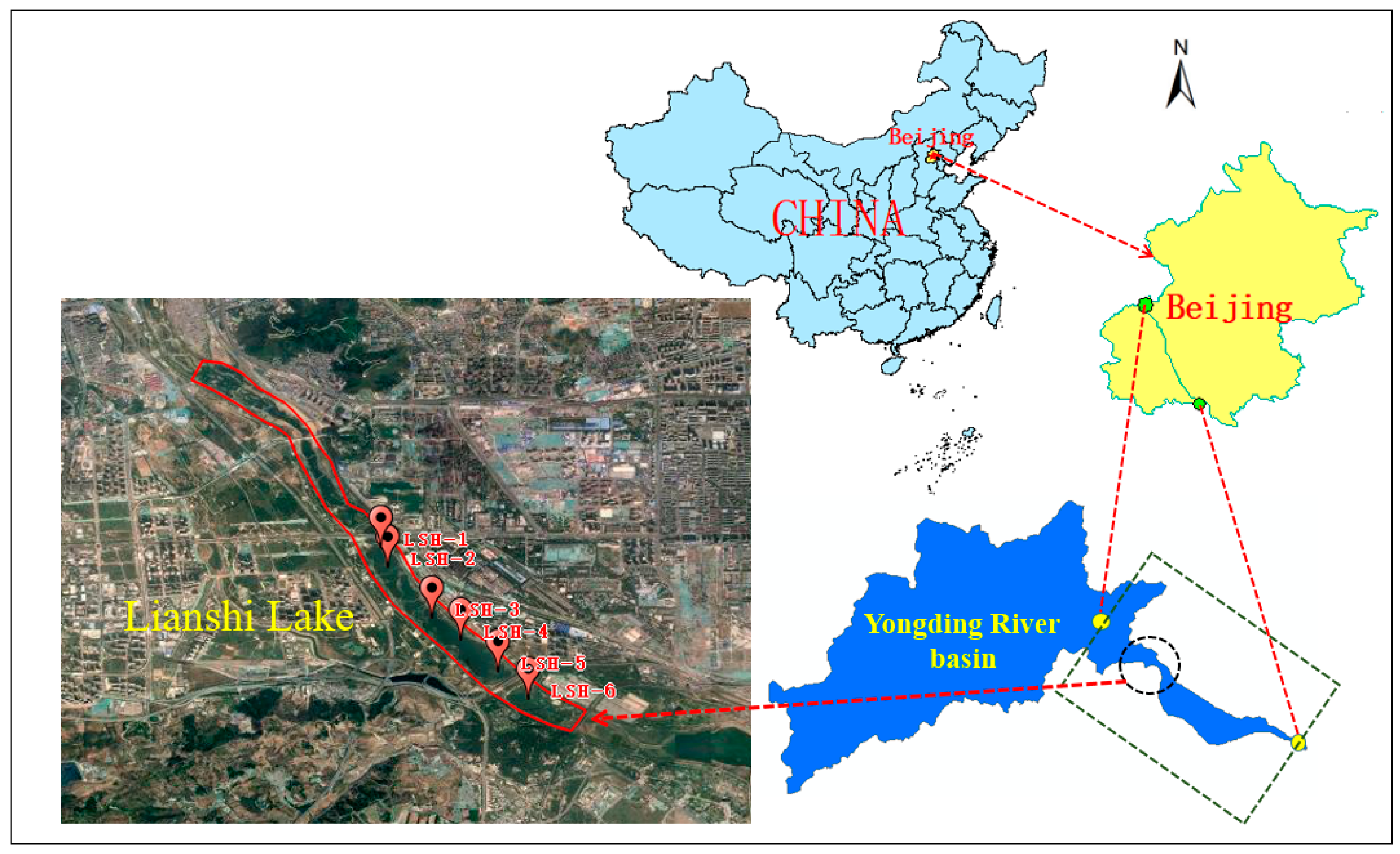
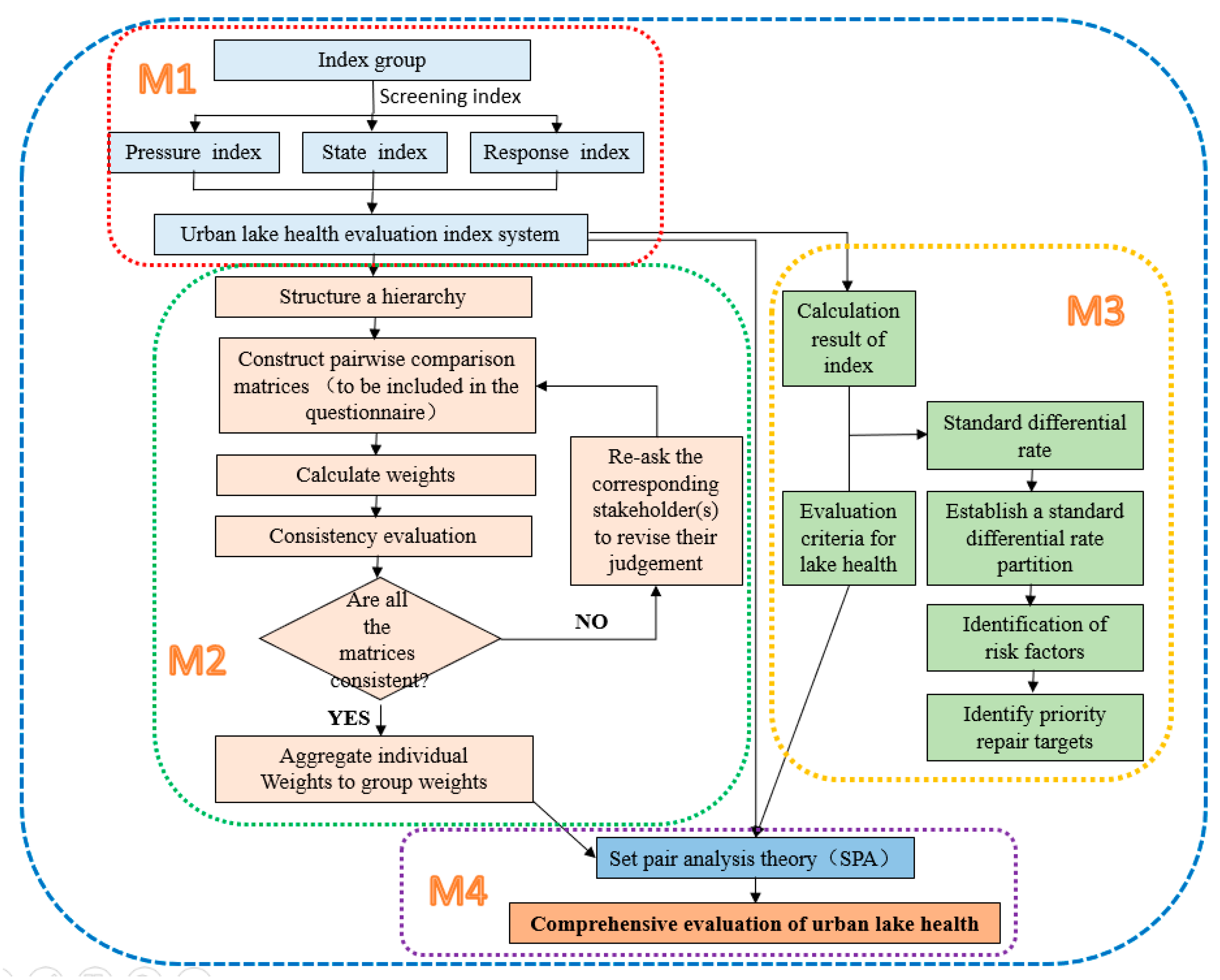
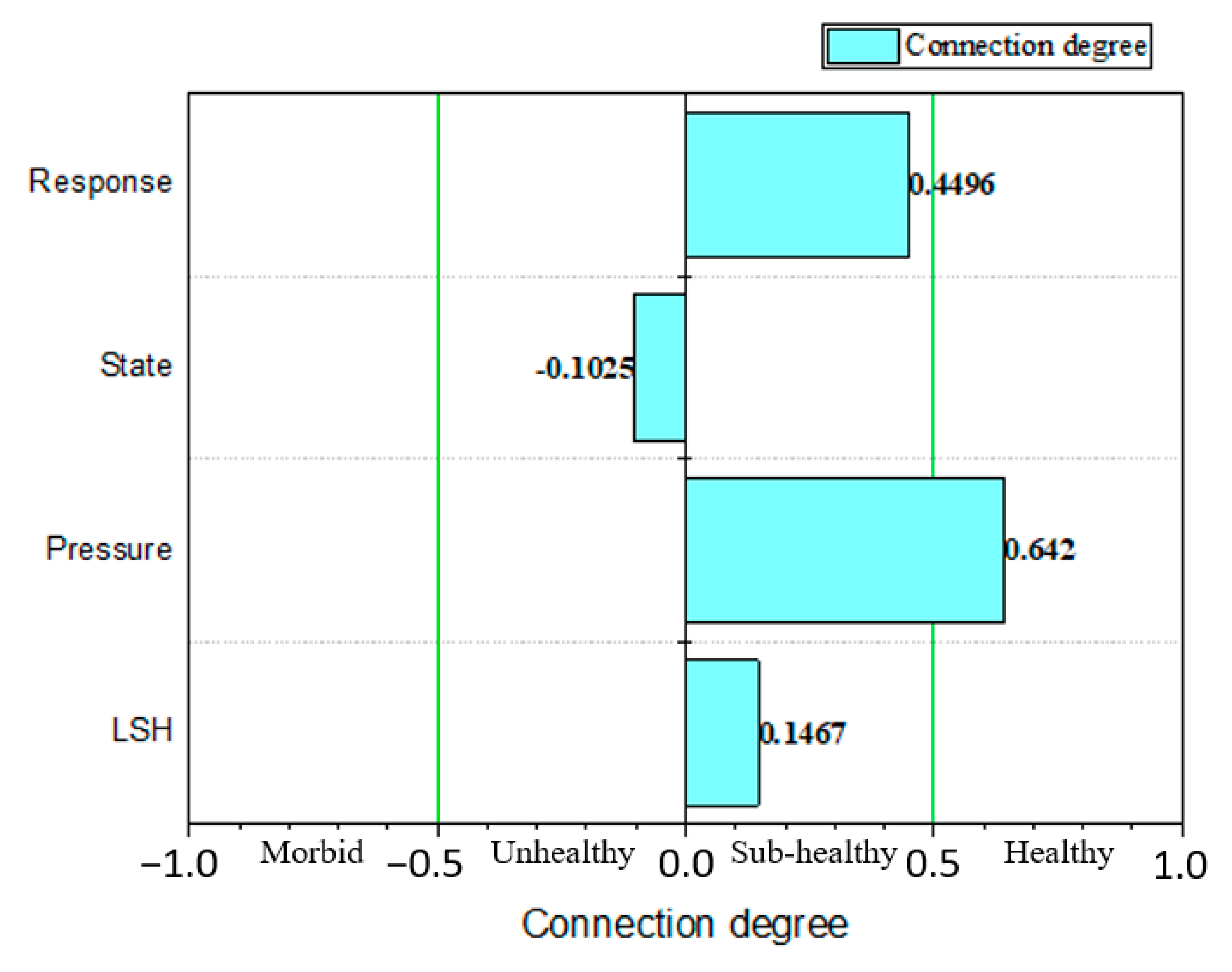
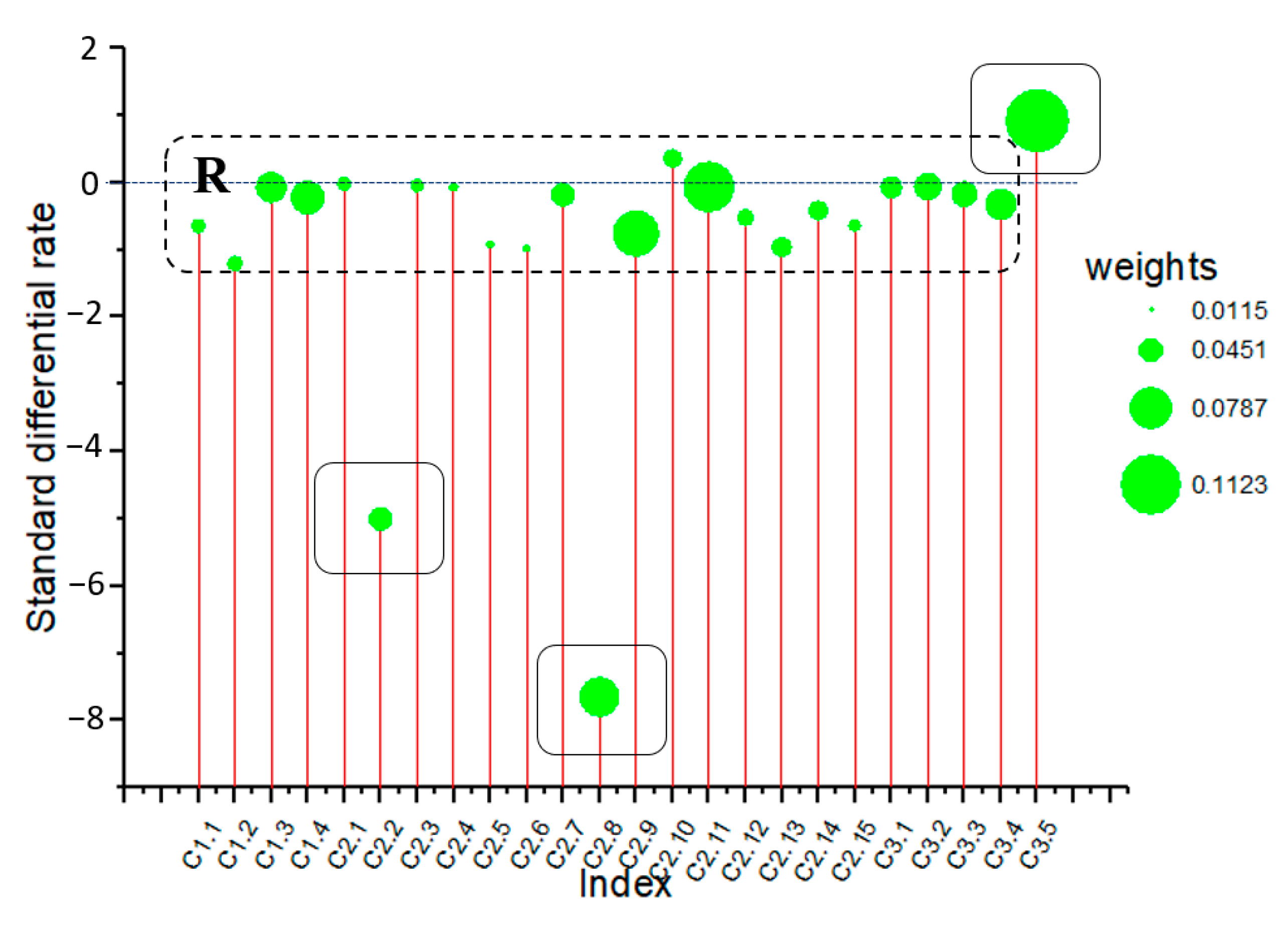
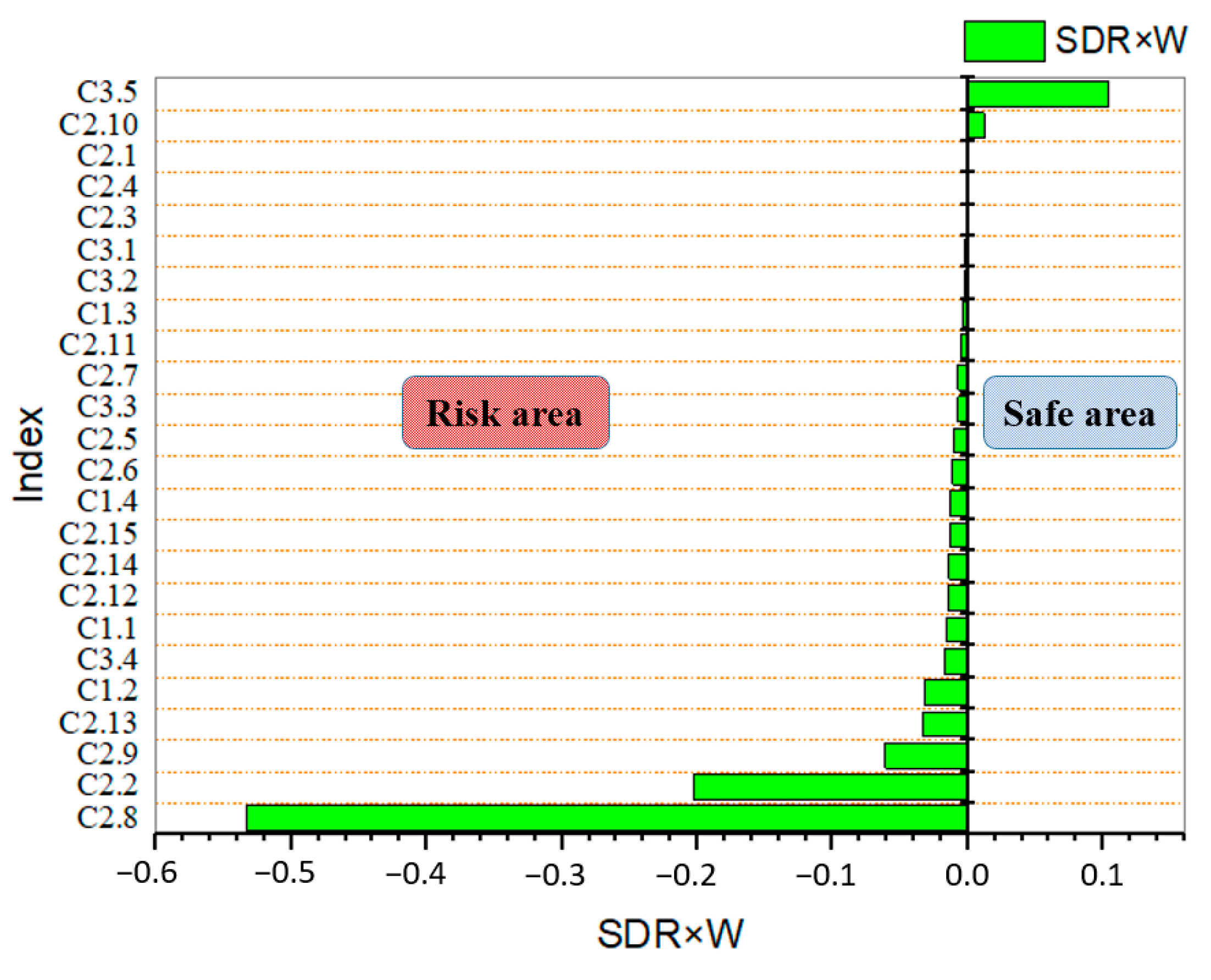
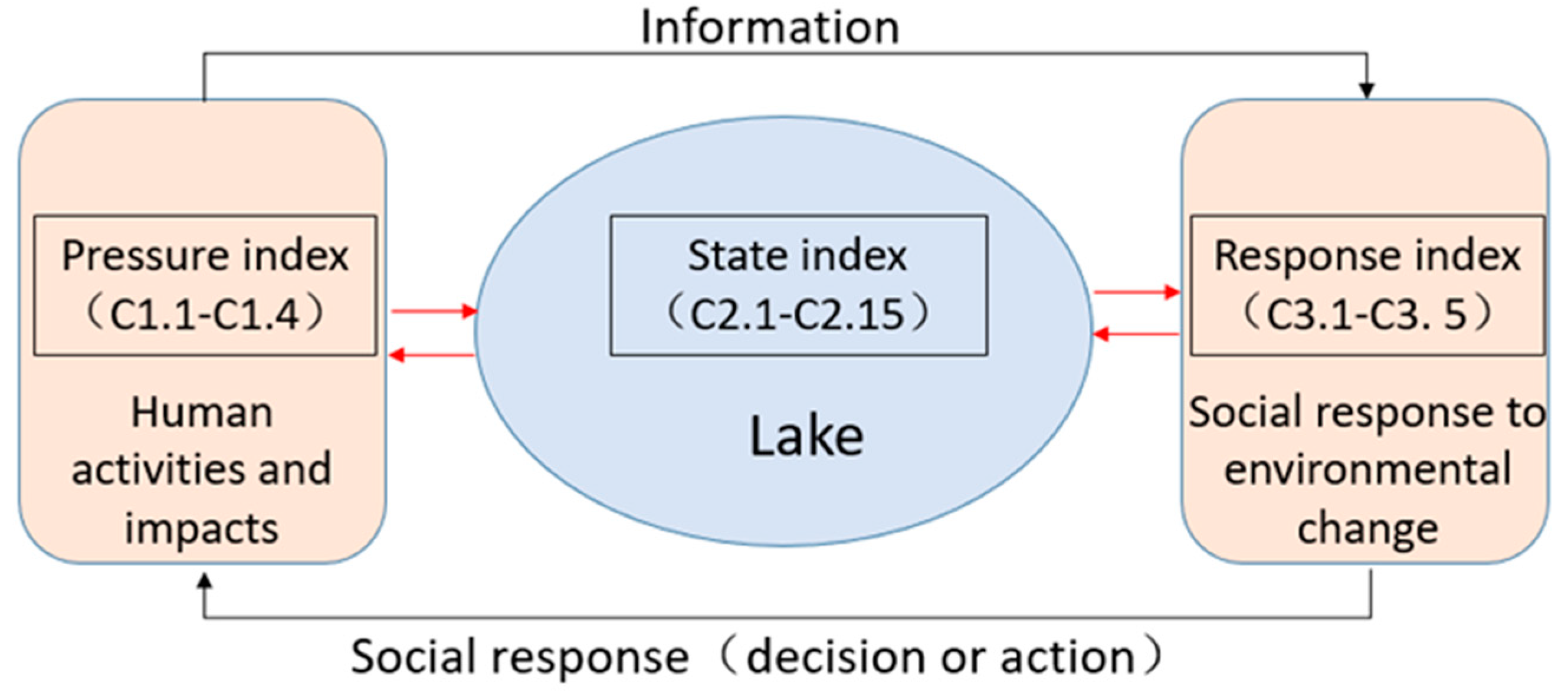
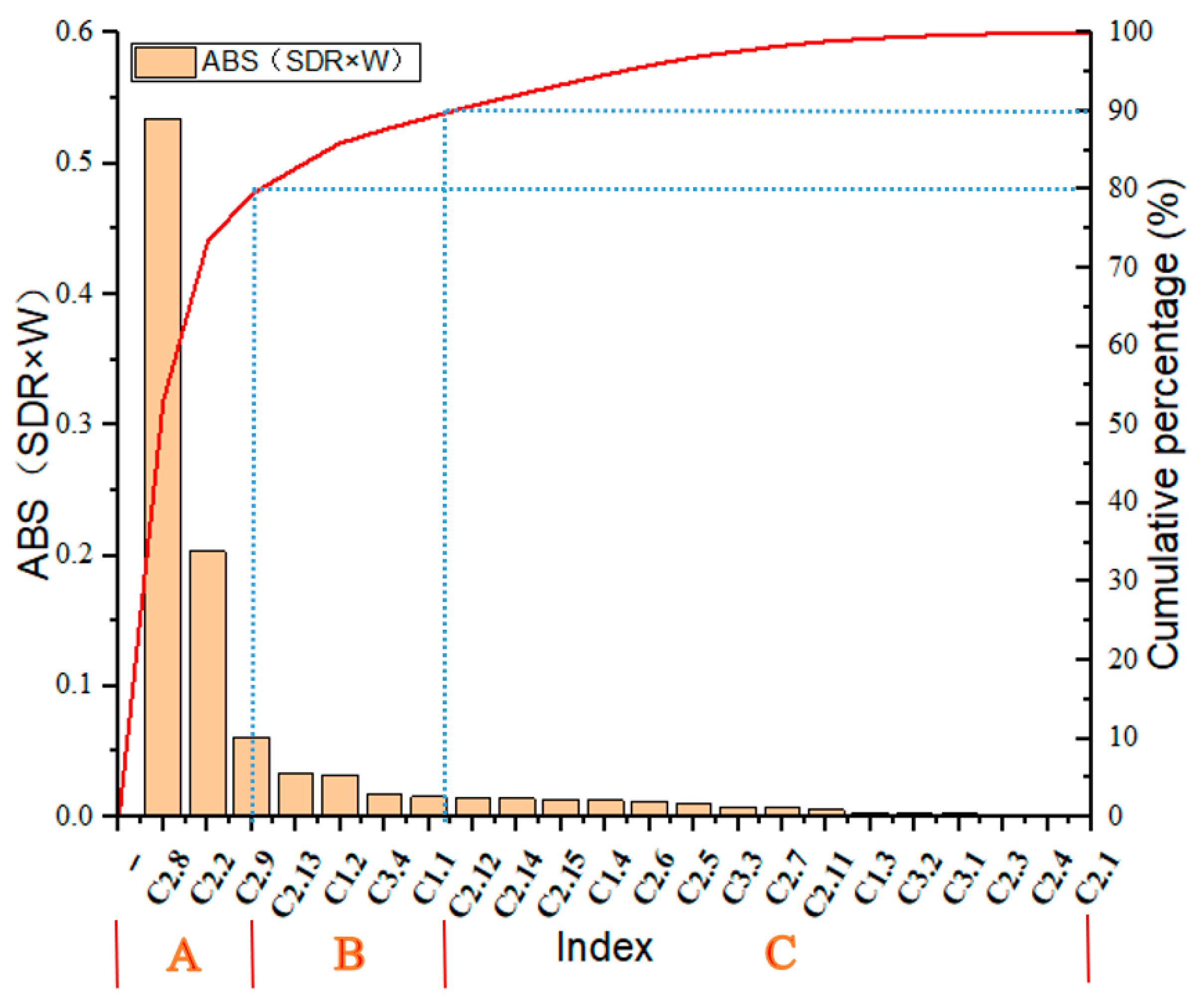
| Objective Layer A | Integrity Criterion Layer B (Weight) | Index Layer C | Unit | Calculation Result | Index Layer C | |
|---|---|---|---|---|---|---|
| Peer Weight | Global Weight | |||||
| Lake Ecological Health A | Pressure B1 (0.1643) | Population density C1.1 | Person/km2 | 164 | 0.1477 | 0.0241 |
| Utilization of water Resources C1.2 | % | 22 | 0.1635 | 0.0267 | ||
| Intensity of pesticide application C1.3 | kg/hm2 | 32 | 0.3270 | 0.0534 | ||
| Intensity of fertilizer application C1.4 | kg/hm2 | 1830 | 0.3618 | 0.0591 | ||
| State B2 (0.5396) | Natural rate of lakeside zone C2.1 | % | 79 | 0.0446 | 0.0241 | |
| Landscape connectivity C2.2 | time/10 km | 12 | 0.0219 | 0.0406 | ||
| The width of the landward radiation belt of the lakeside belt C2.3 | m | 47.8 | 0.0418 | 0.0226 | ||
| Coefficient of shoreline development C2.4 | / | 5.6 | 0.0276 | 0.0149 | ||
| Compactness C2.5 | / | 0.04 | 0.0218 | 0.0118 | ||
| Shape ratio C2.6 | / | 0.03 | 0.0219 | 0.0118 | ||
| Minimum ecological water requirement C2.7 | % | 74 | 0.0761 | 0.0411 | ||
| Lake residence period C2.8 | Day/time | 173 | 0.1294 | 0.0698 | ||
| Eutrophication status C2.9 | / | 52.6 | 0.1506 | 0.0813 | ||
| Heavy metal pollution index C2.10 | / | 96 | 0.0602 | 0.0325 | ||
| Water qualification rate C2.11 | % | 75 | 0.1661 | 0.0896 | ||
| Zooplankton diversity index C2.12 | / | 1.44 | 0.0526 | 0.0284 | ||
| Biomass of large aquatic plants C2.13 | mg/L | 46.7 | 0.0648 | 0.0349 | ||
| Phytoplankton diversity index C2.14 | / | 1.77 | 0.0635 | 0.0343 | ||
| Benthic biodiversity index C2.15 | / | 1.1 | 0.0383 | 0.0207 | ||
| Response B3 (0.2970) | Public satisfaction C3.1 | point | 84 | 0.1289 | 0.0383 | |
| Degree of perfection of relevant laws and regulations C3.2 | point | 85 | 0.1606 | 0.0477 | ||
| Degree of perfection of management functions C3.3 | point | 75 | 0.1481 | 0.0440 | ||
| Environmental investment index C3.4 | % | 1.7 | 0.1845 | 0.0548 | ||
| Regional population quality C3.5 | % | 0.23 | 0.3778 | 0.1122 | ||
| Integrity Criterion Layer B (Weight) | Index Layer C | Unit | Calculation | Data Sources |
|---|---|---|---|---|
| Pressure B1 [39] | Population density (C1.1) | Person/km2 | Urban lake area population/Lake area | Population and area statistics |
| Utilization of water resources (C1.2) | % | Exploitation and utilization of lake water resources/Total lake water resources | Beijing water resources bulletin (2018) and development utilization statistics (2018) | |
| Intensity of pesticide application (C1.3) | kg/hm2 | Actual application amount of cultivation-related agricultural pesticides p.a./Agricultural acreage | Statistical data on actual pesticide use and census data on cultivated land area | |
| Intensity of fertilizer application (C1.4) | kg/hm2 | Actual application amount of cultivation land chemical p.a./Agricultural acreage | Statistical data on actual use of chemical fertilizer and census data on cultivated land area | |
| State B2 [40,41,42,43] | Natural rate of lakeside zone (C2.1) | % | Unspoiled area of a lakeside/Total area of lakeside zone | Ecological environment survey of lakeside zone |
| Landscape connectivity (C2.2) | time/km | Lakeside interrupted by buildings (>100 m) for every 10 km | Ecological environment survey of lakeside zone | |
| Width of landward radiation belt of the lakeside belt (C2.3) | m | Width of the lakeside zone along the lake shoreline | Arithmetic average of multi-section monitoring data obtained according to selected sampling zone | |
| Coefficient of shoreline development (C2.4) | / | Lake shoreline length and lake area size obtained from remote sensing data | ||
| Compactness (C2.5) | / | The longest axis length and size of lake area obtained from remote sensing data | ||
| Shape ratio (C2.6) | / | Minimum circumferential circle A calculated from measurement data, and size of lake area obtained from remote sensing data | ||
| Minimum ecological water requirement guarantee rate (C2.7) | % | Time to reach minimum ecological water requirement/Total time | Based on the principle of ecological hydrology, the water resource function of the lake was analyzed according to monitoring statistics, and the minimum ecological water demand was calculated | |
| Lake residence period (C2.8) | Day/time | Average number of days a lake is updated once | Statistics from lake management department | |
| Eutrophication status (C2.9) | / | Nutritional status index of each parameter obtained by field monitoring data | ||
| Heavy metal pollution index (C2.10) | / | Indicators obtained from water quality monitoring data | ||
| Water qualification rate (C2.11) | % | Monitoring frequency in compliance with specified water quality standards/Total monitoring times | Lake water quality data obtained by field investigation and sampling | |
| Zooplankton diversity index (C2.12) | / | Individual number of zooplankton and individual number of total species obtained by water samples | ||
| Biomass of large aquatic plants (C2.13) | mg/L | Density of large aquatic plants in lakes | Field sampling, survey statistics | |
| Phytoplankton diversity index (C2.14) | / | Individual number of phytoplankton and individual number of total species obtained by water samples | ||
| Benthic biodiversity index (C2.15) | / | Individual number of benthic animals and total number of species obtained from our survey | ||
| Response B3 [39] | Public satisfaction (C3.1) | point | Satisfaction of public investigated and scored through questionnaires | Data obtained from questionnaire survey |
| Degree of perfection of relevant laws and regulations (C3.2) | point | Relevant questionnaires, staff familiar with laws and regulations score | Data obtained from questionnaire survey | |
| Degree of perfection of management functions (C3.3) | / | Staff familiar with lake management measures scored through relevant questionnaires | Data obtained from questionnaire survey | |
| Environmental investment index (C3.4) | % | Total environmental investment/Proportion of GDP | Consulted environmental protection department and obtained statistical data | |
| Regional population quality (C3.5) | % | Number of illiterate/Regional population | Statistical data |
| Index | Unit | Healthy (Level Ⅰ) | Sub-Healthy (Level Ⅱ) | Unhealthy (Level Ⅲ) | Morbid (Level Ⅳ) |
|---|---|---|---|---|---|
| C1.1 | Person/km2 | C < 100 | 100 ≤ C < 300 | 300 ≤ C < 500 | C ≥ 500 |
| C1.2 | % | C < 10 | 10 ≤ C < 20 | 20 ≤ C < 40 | C ≥ 40 |
| C1.3 | kg/hm2 | C < 30 | 30 ≤ C < 60 | 60 ≤ C < 90 | C ≥ 90 |
| C1.4 | kg/hm2 | C < 1500 | 1500 ≤ C < 3000 | 3000 ≤ C < 4500 | C ≥ 4500 |
| C2.1 | % | 100 > C ≥ 80 | 80 > C≥60 | 60 > C ≥ 40 | C < 40 |
| C2.2 | time/km | C < 2 | 2 ≤ C < 6 | 6 ≤ C < 10 | C ≥ 10 |
| C2.3 | m | C ≥ 50 | 50 > C ≥ 30 | 30 > C ≥ 10 | C < 10 |
| C2.4 | / | C ≥ 6 | 6 > C ≥ 2 | 2 > C ≥ 0.5 | C < 0.5 |
| C2.5 | / | C ≥ 0.5 | 0.5 > C ≥ 0.3 | 0.3 > C ≥ 0.1 | C < 0.1 |
| C2.6 | / | C ≥ 0.5 | 0.5 > C ≥ 0.3 | 0.3 > C ≥ 0.1 | C < 0.1 |
| C2.7 | % | 100 > C ≥ 90 | 90 > C ≥ 75 | 75 > C ≥ 50 | C < 50 |
| C2.8 | Day/time | C < 20 | 20 ≤ C < 40 | 40 ≤ C < 90 | C ≥ 90 |
| C2.9 | / | C < 30 | 30 ≤ C < 50 | 50 ≤ C < 70 | C ≥ 70 |
| C2.10 | / | C < 150 | 150 ≤ C < 300 | 300 ≤ C < 1200 | C ≥ 1200 |
| C2.11 | % | C ≥ 80 | 80 > C ≥ 70 | 70 > C ≥ 60 | C < 60 |
| C2.12 | / | C ≥ 1.5 | 1.5 > C ≥ 0.8 | 0.8 > C ≥ 0.2 | C < 0.2 |
| C2.13 | mg/L | C ≥ 1000 | 1000 > C ≥ 500 | 500 > C ≥ 100 | C < 100 |
| C2.14 | / | C ≥ 1.5 | 1.5 > C ≥ 0.8 | 0.8 > C ≥ 0.2 | C < 0.2 |
| C2.15 | / | C ≥ 1.5 | 1.5 > C ≥ 0.8 | 0.8 > C ≥ 0.2 | C < 0.2 |
| C3.1 | point | C ≥ 90 | 90 > C ≥ 80 | 80 > C ≥ 70 | C < 70 |
| C3.2 | point | C ≥ 90 | 90 > C ≥ 70 | 70 > C ≥ 60 | C < 60 |
| C3.3 | point | C ≥ 90 | 90 > C ≥ 70 | 70 > C ≥ 60 | C < 60 |
| C3.4 | % | C ≥ 2.5 | 2.5 > C ≥ 2 | 2 > C ≥ 1.5 | C < 1.5 |
| C3.5 | % | C < 3 | 3≤C < 6 | 6≤C < 12 | C≥12 |
| C in each row represents the value of the row index. | |||||
| Health Classification | Health Status | Ecosystem Characteristics |
|---|---|---|
| Level I | Healthy (3–5) | Ecological structure is reasonable, the system is highly dynamic, external pressure is small, no ecological abnormality, perfect ecological function, system is in stable and sustainable state |
| Level Ⅱ | Sub-healthy (2–3) | Ecological structure is reasonable, pattern is still perfect, system is vigorous, external pressure is small, no ecological abnormality, ecosystem function relatively perfect, system still stable, ecosystem sustainable |
| Level Ⅲ | Unhealthy (1–2) | Ecological structure reasonable, pattern is still perfect, external pressure relatively large, close to ecological threshold, more sensitive areas, a few ecological abnormalities, able to function ecologically, ecosystem can be maintained |
| Level Ⅳ | Morbid (0–1) | Ecological structure is defective, system vitality low, external pressure is great, ecological function cannot meet the needs of maintaining the region, ecological system begins to degenerate |
| Index | Connection Degree of Comprehensive Assessment | Result |
|---|---|---|
| Lake healthy | 0.1467 | |
| Pressure | 0.6420 | |
| State | −0.1025 | |
| Response | 0.4496 |
© 2020 by the authors. Licensee MDPI, Basel, Switzerland. This article is an open access article distributed under the terms and conditions of the Creative Commons Attribution (CC BY) license (http://creativecommons.org/licenses/by/4.0/).
Share and Cite
Su, W.; Wu, J.; Zhu, B.; Chen, K.; Peng, W.; Hu, B. Health Evaluation and Risk Factor Identification of Urban Lakes—A Case Study of Lianshi Lake. Water 2020, 12, 1428. https://doi.org/10.3390/w12051428
Su W, Wu J, Zhu B, Chen K, Peng W, Hu B. Health Evaluation and Risk Factor Identification of Urban Lakes—A Case Study of Lianshi Lake. Water. 2020; 12(5):1428. https://doi.org/10.3390/w12051428
Chicago/Turabian StyleSu, Wei, Jiapeng Wu, Bei Zhu, Kaiqi Chen, Wenqi Peng, and Baoyue Hu. 2020. "Health Evaluation and Risk Factor Identification of Urban Lakes—A Case Study of Lianshi Lake" Water 12, no. 5: 1428. https://doi.org/10.3390/w12051428
APA StyleSu, W., Wu, J., Zhu, B., Chen, K., Peng, W., & Hu, B. (2020). Health Evaluation and Risk Factor Identification of Urban Lakes—A Case Study of Lianshi Lake. Water, 12(5), 1428. https://doi.org/10.3390/w12051428





